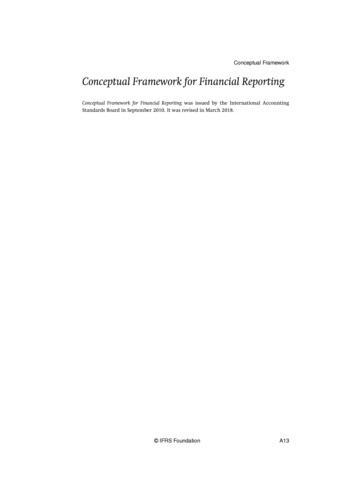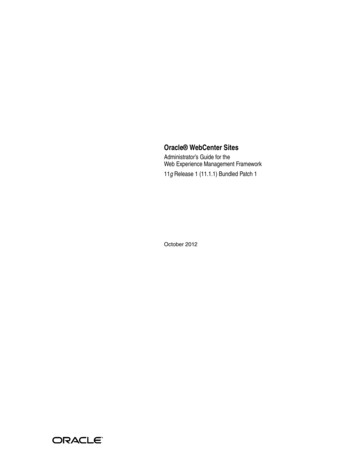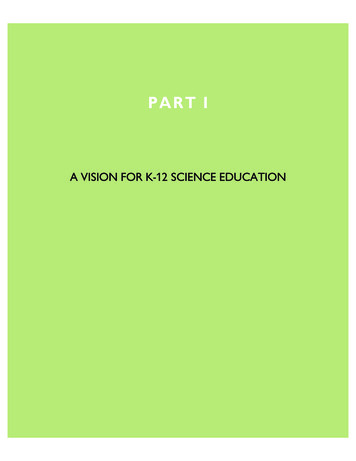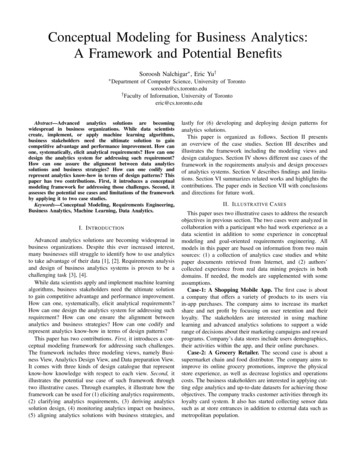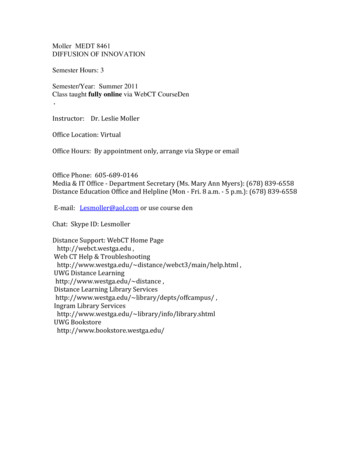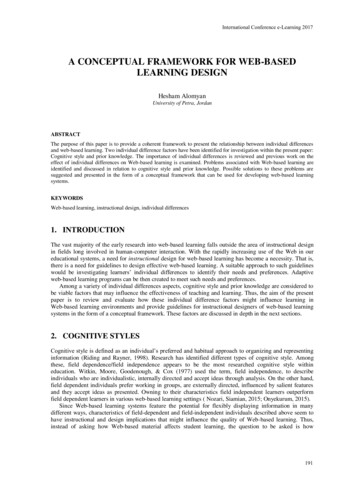
Transcription
International Conference e-Learning 2017A CONCEPTUAL FRAMEWORK FOR WEB-BASEDLEARNING DESIGNHesham AlomyanUniversity of Petra, JordanABSTRACTThe purpose of this paper is to provide a coherent framework to present the relationship between individual differencesand web-based learning. Two individual difference factors have been identified for investigation within the present paper:Cognitive style and prior knowledge. The importance of individual differences is reviewed and previous work on theeffect of individual differences on Web-based learning is examined. Problems associated with Web-based learning areidentified and discussed in relation to cognitive style and prior knowledge. Possible solutions to these problems aresuggested and presented in the form of a conceptual framework that can be used for developing web-based learningsystems.KEYWORDSWeb-based learning, instructional design, individual differences1. INTRODUCTIONThe vast majority of the early research into web-based learning falls outside the area of instructional designin fields long involved in human-computer interaction. With the rapidly increasing use of the Web in oureducational systems, a need for instructional design for web-based learning has become a necessity. That is,there is a need for guidelines to design effective web-based learning. A suitable approach to such guidelineswould be investigating learners’ individual differences to identify their needs and preferences. Adaptiveweb-based learning programs can be then created to meet such needs and preferences.Among a variety of individual differences aspects, cognitive style and prior knowledge are considered tobe viable factors that may influence the effectiveness of teaching and learning. Thus, the aim of the presentpaper is to review and evaluate how these individual difference factors might influence learning inWeb-based learning environments and provide guidelines for instructional designers of web-based learningsystems in the form of a conceptual framework. These factors are discussed in depth in the next sections.2. COGNITIVE STYLESCognitive style is defined as an individual’s preferred and habitual approach to organizing and representinginformation (Riding and Rayner, 1998). Research has identified different types of cognitive style. Amongthese, field dependence/field independence appears to be the most researched cognitive style withineducation. Witkin, Moore, Goodenough, & Cox (1977) used the term, field independence, to describeindividuals who are individualistic, internally directed and accept ideas through analysis. On the other hand,field dependent individuals prefer working in groups, are externally directed, influenced by salient featuresand they accept ideas as presented. Owning to their characteristics field independent learners outperformfield dependent learners in various web-based learning settings ( Nozari, Siamian, 2015; Onyekurum, 2015).Since Web-based learning systems feature the potential for flexibly displaying information in manydifferent ways, characteristics of field-dependent and field-independent individuals described above seem tohave instructional and design implications that might influence the quality of Web-based learning. Thus,instead of asking how Web-based material affects student learning, the question to be asked is how191
ISBN: 978-989-8533-63-0 2017Web-based learning is used by learners with different cognitive styles? The following subsections discussthis issue within three areas: (a) field dependence and hypermedia structure; (b) field dependence andlearning behaviour; and (c) field dependence and learning outcomes.2.1 Field Dependence and Hypermedia StructureResearch has investigated how learners with diverse cognitive styles cope with different hypermediastructures. Empirical studies (e.g. Graff, 2003; Ipek, 2010; Reed & Oughton, 1997) revealed that:a) field-independent learners are relatively capable of directing their learning by themselves inb)hypermedia programs with non-linear presentation.field-dependent learners appear to prefer more structured paths to follow in linear learningprograms. That is, they prefer to be externally directed.2.2 Field Dependence and Learning BehaviorLearning behaviours can be considered as learners’ interaction patterns with learning materials, instructors,tutors, and peers. In the context of hypermedia learning systems, Research (e.g Ford & Chen, 2000;Somyurek, Guyer, & Atasoy, 2008 ) indicated that field-dependent students preferred navigational tools suchas global maps, which provided an overall picture of the contents, whereas field-independent studentspreferred tools such as an index or find options, designed for searching for specific information. In addition,other studies (Palmquist & Kim, 2000; Wang, Hawk, & Tenopir, 2000) showed that field-dependent learnersnavigate the Web in a more linear mode and they get lost more frequently. However, among individuals withsubstantial online search experience, their cognitive style did not seem to influence any of the searchperformance or tool usage. Therefore, it might be argued that cognitive style appears as an important factorin designing navigation tools which should be presented in the user interface for learning and teaching.2.3 Field Dependence and Learning OutcomeThe field dependent/independent cognitive style has been identified as an influential factor in academicachievement in both traditional and hypermedia learning settings. In traditional learning settings,field-independent students frequently perform better than field-dependent students in various subject matters(Jamieson, 1992).In hypermedia learning settings, although research is still inconclusive, the majority of works availableindicate that field-independent students will score significantly better than field-dependent students (Noble,Miller, & Heckman, 2008; Nozari & Siamian, 2015). This outperformance of the field-independent studentscan be attributed to their ability to impose their own organization of structure on learning materials.However, research showed that when sufficient structure and support are provided in hypermedia learningenvironments (e.g., menu of contents, back/forward navigation buttons, indexes etc.) field-dependentstudents may overcome the limitations of imposing effective structure on their learning enabling them toperform as good as their peers. The remaining subsections discuss problems field-dependent learners, mayencounter whilst learning in hypermedia systems. These problems are: (a) disorientation, (b) learner control,and (c) cognitive overload.2.4 Problems Field-Dependent Learners Experience in Web-Based Learning2.4.1 DisorientationDisorientation refers to users not knowing their position in hypermedia space (Murray, Piemonte, Khan,Shen, & Condit, 2000). It has been observed that field-dependent learners, as opposed to field-independentlearners, are more likely to become disoriented during navigation in hyperspace and non-linear hypermediasystems (Palmquist & Kim, 2000; Wang et al., 2000).It is possible that the ability of field-independent individuals to take an active approach, applyorganization on information and extract relevant cues helps them find their way in non-linear learning192
International Conference e-Learning 2017environments. Conversely, field-dependent students tend to adopt an approach where they prefer guidanceand attend to the most salient cues regardless of their relevance. Therefore, to learn effectively,field-dependent learners need to be provided with more instructional guidance in Web-based learning, whichcan direct them to the relevant information and reduce disorientation.2.4.2 Cognitive OverloadCognitive overload described as the additional effort and concentration necessary to maintain several tasks ortrails at one time (Conklin, 1987). This problem can be caused by a large number of choices and decisionsthe user has to make in a hypermedia system. For field-dependent learners, freedom of navigation couldmean confusion and their attention may be diverted from content and relationships as they attend tonavigational decision making, especially when accessing large quantities of information. Cognitive overloadcould also be a result of the ability of hypermedia to present content material in various textual as well asstatic and dynamic pictorial representations which might become a burden on learner cognition. Suchmultiple representations might make specific demands on learners. That is, learners have to process differentrepresentations simultaneously to construct a coherent mental representation which, in turn, might causelearnersto experience cognitive overload. No published studies have directly investigated the relationshipbetween cognitive style and cognitive overload in Web-based learning environments. However, a number ofresearchers (Palmquist & Kim, 2001; Wang et al., 2000) have suggested that field-dependent learners aremore likely to experience cognitive overload.2.4.3 Learner ControlLearner control can be defined as the amount of control a learner can have, in an individualised learningenvironment on the leaning material (Lin & Hsieh, 2001). With regard to cognitive style, empirical studieshave suggested that field-dependent learners tend to perform better in program-controlled instruction andprefer to be externally guided, whereas field-independent learners often tend to do well in independentlearning (Chen & Macredie, 2002). It can be argued that field-dependent individuals might gain benefit fromhypermedia learning systems when less learner control and more guidance are provided. On the other hand,relatively, field-independent individuals enjoy independent learning in hypermedia systems provided withhigh levels of learner control.Solutions offered to help learners, in particular field-dependent learners, overcome the mentionedproblems and perform well in hypermedia learning environments are presented in section 4. The next sectionillustrates and discusses the importance of prior knowledge in hypermedia learning.3. PRIOR KNOWLEDGE AND WEB-BASD LEARNINGPrior knowledge is considered to be a key factor underlying successful learning. Jonassen and Grabowski(1993, p. 417) defined prior knowledge as “the knowledge, skills, or ability that students bring to the learningprocess. A number of educators and researchers (e.g., Chen, Fan & Macredie, 2006; Chen & Paul, 2003)have recognised prior knowledge as a potent factor that might help them analyse the way in which learnersnavigate and perform in a non-linear learning environment. Empirical studies in hypermedia learning settings(e.g., Calisir & Gurel, 2003; Chen, 2015; Song, Kalet, & Plass, 2016; Tabatabai & Shore, 2005) showed thatlearners with high prior knowledge frequently outperform learners with limited prior knowledge and learnerswith varying levels of prior knowledge show different navigational behaviour and their performance is oftenaffected by types of content structure.With regard to navigation, research (e.g., Calisir & Gurel, 2003; Chen, Fan, & Macredie, 2006) shows thatstudents with high prior knowledge of the content do not experience disorientation with hypermedia andseem to experience much less frustration while performing their tasks. On the other hand, students with lowprior knowledge often suffer from disorientation, exhibited little awareness of where they had been, or wherethey could go to find the information that they needed.Regarding content structure, research suggests that experts and novices differ in their performancedepending on content structure in hypermedia learning systems (Calisir & Gurel, 2003). It was found that lowprior knowledge students benefited more from a hierarchical and linear structure than from a network linkingstructure. Whereas, High prior knowledge students were able to function equally well in both conditions. Insummary, prior knowledge appears to be a viable factor that predicts the way learners react to hypermedialearning system.193
ISBN: 978-989-8533-63-0 20174. A PROPSED FRAMEWORK FOR WEB-BASED LEARNING DESIGNDrawn from the preceding analysis of the literature, a conceptual framework is developed, as shown inFigure 1 and 2, and suggests several techniques that can be used to address the problems field-dependent andlow prior knowledge learners encounter in web-based learning environments. The conceptual frameworkillustrates the basic characteristics of individuals with field-independent and field-dependent cognitive styleand individuals with high and low levels of prior knowledge and their requirements for Web-based learningsystems. The proposed framework can help designers to develop web-based learning systems that addresseffectively the needs of learners with different types of cognitive style and levels of prior knowledge.Characteristics of field-independent and field-dependent individualsField-dependent individualsField-independent Individuals- Active learners (discovery approach)- Internally directed- Analytic fashion & self-structuring- Passive learners- Externally directed- Global fashionSystem SupportNavigation SupportFree navigation- Index, find & Menu- Internal gravitationalcuesContent StructureNavigation SupportContent structureNon-linear presentations- Ill-structured material(Impose their own structure oncontent)- Learner-controlledinstructionGuided navigation- Salient & relevant cues (e.g.,path indicators, main menus)- global maps (e.g.,navigational concept maps)Linear & structuredpresentations- Explicit structured material (for example using concept maps& integrated multimediapresentations)- Program-controlled instructionFigure 1. Characteristics of field-independent and dependent-individuals and their implications for Web-based learningCharacteristics of high prior knowledge and low prior knowledge individualsHigh Prior Knowledge IndividualsLow Prior Knowledge Individuals- Highly organised schemata- Deep processing strategies- Able to create structure of the domain- A great deal of understanding of the content- Chaotic & disjointed schemata- Surface processing strategies- Lack of conceptual structure of the domain- Short of understanding of the contentSystem SupportNavigation SupportContent StructureFree navigation- Flexible paths (e.g., searchengines, alphabetical indices)to help them findspecific informationNetwork Structure- Ill-structured material- Able to impose structure asthey have a mental model of thecontentNavigation SupportGuided navigation- Fixed paths or flexiblepaths with advisement- Visual cues- Hierarchical mapsContent structureHierarchical structure- Hierarchical map- Advance organizers- Coherent materialto help them integrate knowledgeFigure 2. Characteristics of high and low prior knowledge individuals and their implications for Web-based learning5. CONCLUSIONThe manner in which individual differences may interact with web-based material is the major topic of thispaper. In particular, it is noted that field-independent individuals do appear to have certain advantages overfield-independent peers in many learning situations, especially situations where learners need to imposestructure upon a relatively incomplete or disorganised input. However, under certain conditions and withstronger (more organised, more direct) instructional cues field-dependent individuals may learn at similarlevels to field-independent individuals.Prior knowledge seems to operate in a similar manner as cognitive style. Individuals with high levels ofprior knowledge appear to be better able to learn and perform in less structured domains, through using theirexisting knowledge as an effective learning tool. On the other hand, this is not the case with low prior194
International Conference e-Learning 2017knowledge learners, whose knowledge cannot assist them in dealing with new information. Such learnerscannot rely on their prior knowledge to help them determine the underlying structure of the new learningmaterial. Like field-dependent individuals, individuals with low prior knowledge need more guidance in theirlearning process. Consequently, the framework proposed in the present paper suggests several techniques thatcan be used in web-based learning systems to assist both field-dependent students and students with low priorknowledge in their learning experience and improve learning outcomes.REFERENCESCalisir, F., & Gurel, Z. (2003). Influence of text structure and prior knowledge of the learner on reading comprehension,browsing and perceived control. Computers in Human Behavior, 19, 135–145.Chen, L. (2015). Web-based learning programs: Use by learners with various cognitive styles. Computers & Education,54, 4, 1028-1035.Chen, S. Y., Fan, J., & Macredie, R. D. (2006). Navigation in hypermedia learning systems: Experts vs. novices.Computers in Human Behavior, 22, 251–266.Conklin, J. (1987). Hypertext: An introduction and surveys. IEEE Computer, 20, 17-41.Ford, N., & Chen, S. Y. (2000). Individual differences, hypermedia navigation and learning: An empirical study. Journalof Educational Multimedia and Hypermedia, 9, 281– 312.Graff, M. (2003). Cognitive style and attitudes towards using online learning and assessment methods. Electronic Journalof e-Learning, 1, 21-28.Ipek, I. (2010). The effects of CBI lesson sequence type and field dependence on learning from computer-basedcooperative instruction in web. Turkish Online Journal of Educational Technology, 9, 221-234.Jamieson, J. (1992). The cognitive styles of reflection/impulsivity and field independence/dependence and ESL success.Modern Language Journal, 3, 491-501.Jonassen, D. H., & Grabowski, B. (1993). Individual differences and instruction. New York: Allen & Bacon.Murray, T., Piemonte, J., Khan, S., Shen, T., & Condit, C. (2000). Evaluating the need for intelligence in an adaptivehypermedia system. In Frasson & Gautheir (Eds.), Proceedings of Intelligent Tutoring Systems (373-382), SpringerVerlag, New York.Noble, K. A., Miller, S. M., & Heckman, J. (2008). The Cognitive Style of Nursing Students: Educational Implicationsfor Teaching and Learning. Journal of Nursing Education, 47, 6, 245-253.Nozari. A., & Siamian. H. (2015). The relationship between field dependent-independent cognitive style andunderstanding of English text reading and academic success. Mater Sociomed. 27, 39-41.Onyekuru, B. (2015). Field dependence-field independence cognitive style, gender, career choice and academicachievement of secondary school students in Emohua local government area of rivers state. Journal of Education andPractice. 6, 76-86Palmquist, R. A., Kim, K.-S. (2000). Cognitive style and on-line database search experience as predictors of Web searchperformance. Journal of the American Society for Information Science, 51, 558–566.Reed, W. M., & Oughton, J. M. (1997). Computer experience and interval based hypermedia navigation. Journal ofResearch on Computing in Education, 30, 38–52.Somyurek.S., Guyer.T., & Atasoy.B,. ( 2008). the effects of individual differences on learner’s navigation in acourseware. The Turkish Online Journal of Educational Technology, 7, 39-41.Song, S.; Kalet, L., & Plass, L. (2016). Interplay of prior knowledge, self-regulation and motivation in complexmultimedia learning environments. Journal of Computer Assisted Learning, 32, 1, 31-50.Tabatabai, D., & Shore, B. M. (2005). How experts and novices search the Web. Library & Information ScienceResearch, 27, 222–248.Wang, P., Hawk, W. B., & Tenopir, C. (2000). Users’ interaction with World Wide Web resources: An exploratory studyusing a holistic approach. Information processing & Management, 36, 229–251.Witkin, H. A., Moore, C. A., Goodenough, D. R., & Cox, P. W. (1977). Field dependent and field independent cognitivestyles and their educational implications. Review of Educational Research, 47, 1-64.Riding R. J., & Rayner, S. (1998). Cognitive styles and learning strategies: Understanding style differences in learninandbehaviour. London: David Fulton.Lin, B & Hsieh,C.(2001).Web-based teaching and learner control:A research review.Computers & Education,37,377-386195
design for web-based learning has become a necessity. That is, there is a need for guidelines to design effective web-based learning. A suitable approach to such guidelines would be investigating learners’ individual differences to identify their needs and preferences. Adaptive web-bas



